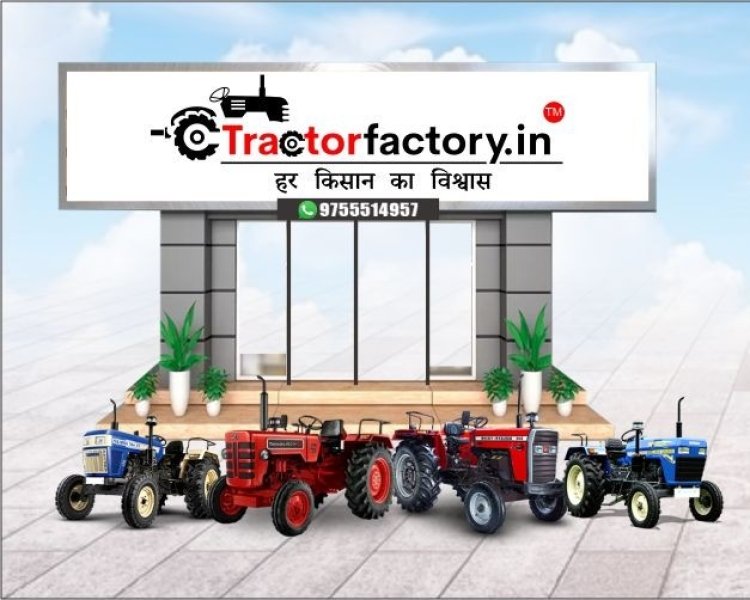Steps to Troubleshoot Common Tractor Issues
Tractor Factory is a best platform where you can buy and sell old tractor at a reasonable cost. We have a 40+ brands second hand tractor are listed on our website. You can select a used tractor to purchase for yourself. We believe in growth of farmars and offer best quality and 100% checked tractors.
Share this Post to earn Money ( Upto ₹100 per 1000 Views )

Tractors are essential tools for many farmers and landowners, handling everything from plowing fields to transporting materials. However, like any piece of machinery, they can occasionally experience issues. Identifying and fixing problems early can help avoid costly repairs and downtime. Below are the steps to troubleshoot common tractor problems.
1. Check the Fuel System
A lack of fuel or issues with the fuel system are one of the most frequent problems. If your tractor isn’t starting, start by ensuring there’s enough fuel in the tank. If the fuel is fine, you’ll want to check for the following:
- Fuel filter: A clogged fuel filter can impede fuel flow, preventing the engine from starting. Replace or clean the filter if necessary.
- Fuel lines: Inspect for any cracks, leaks, or blockages in the fuel lines. A damaged fuel line could prevent proper fuel delivery to the engine.
- Fuel pump: If there’s no fuel reaching the engine, the fuel pump may be faulty. Ensure the pump is working or replace it if needed.
2. Inspect the Battery and Electrical System
Electrical issues are another common culprit for tractor failure. If your tractor is turning over slowly or not at all, follow these steps:
- Battery charge: Ensure the battery is charged. If it’s weak or dead, replace or jump-start the battery.
- Connections and terminals: Corroded or loose battery terminals can cause poor connections, preventing the tractor from starting. Clean and tighten connections as needed.
- Alternator: If the battery is not charging while the engine is running, the alternator could be faulty and needs to be tested or replaced.
3. Check the Engine Oil and Coolant
Engine oil and coolant levels are essential for maintaining a properly running tractor. Low levels of either can cause overheating or engine failure.
- Engine oil: Check the oil level using the dipstick. If the oil level is low, top it off with the recommended oil. If the oil looks dirty or gritty, consider changing it.
- Coolant: Ensure the coolant level is adequate. Low coolant can cause overheating. If the engine has overheated, check for leaks or problems with the radiator or thermostat.
4. Examine the Air Filter
A clogged or dirty air filter can limit airflow to the engine, causing poor performance or difficulty starting. Inspect the air filter for dirt and debris:
- Clean or replace the filter: If it’s dirty, clean it if reusable, or replace it with a new one.
- Check the intake: Ensure the intake system is free of blockages that might prevent clean air from reaching the engine.
5. Inspect the Starter Motor and Solenoid
If the tractor refuses to start but the battery is fine, there could be an issue with the starter motor or solenoid.
- Starter motor: Check for signs of wear or damage. If the starter motor is faulty, it may need to be replaced.
- Solenoid: The solenoid controls the flow of electricity from the battery to the starter motor. If the solenoid fails, it may not deliver power to the starter, preventing the engine from cranking.
6. Check the Transmission
Transmission issues often result in poor movement or the inability to change gears. If your tractor isn't shifting properly, consider the following:
- Clutch issues: A worn or damaged clutch can cause difficulties in shifting. Check for signs of wear, and if the clutch is slipping or not engaging, consider replacing it.
- Fluid levels: Check the transmission fluid level, as low fluid can cause erratic shifting or transmission failure. Refill if necessary and look for leaks.
- Linkage or cables: Ensure that the transmission linkage and gear shifters are properly adjusted and not obstructed or damaged.
7. Inspect the Tires
Tire issues can affect traction and performance, especially in rough or uneven terrain. Check the tires for the following:
- Pressure: Low tire pressure can reduce traction and affect stability. Inflate tires to the manufacturer’s recommended pressure.
- Wear: Inspect tires for signs of excessive wear or damage. If a tire is worn unevenly or has visible cracks, it may need to be replaced.
- Tire alignment: Misaligned tires can cause uneven wear and poor handling. Check the alignment and adjust as necessary.
8. Check the Hydraulics
Hydraulic systems are essential for operating attachments like loaders, backhoes, and other implements. If the hydraulic system isn’t working properly:
- Hydraulic fluid: Ensure the hydraulic fluid is at the correct level. Low fluid can cause sluggish or unresponsive hydraulic movements.
- Leaks: Inspect hydraulic hoses and fittings for leaks. A leak can quickly deplete hydraulic fluid and render the system ineffective.
- Filters: Dirty or clogged hydraulic filters can restrict fluid flow. Replace or clean the filters regularly.
9. Listen for Unusual Noises
Unusual noises, such as knocking, squealing, or grinding, can indicate specific mechanical issues. Pay attention to the following:
- Knocking or tapping: This could be an issue with the engine, such as a problem with the valves or pistons.
- Grinding: If you hear grinding when shifting gears, it may indicate a problem with the transmission or clutch.
- Squealing: Squealing sounds could indicate worn belts or pulleys. Check the drive belts for wear or damage and replace if necessary.
10. Consult the Owner’s Manual
When in doubt, refer to the tractor’s owner’s manual for troubleshooting advice. Manufacturers often include troubleshooting guides, maintenance schedules, and part numbers to make repairs easier.
By following these troubleshooting steps, you can often identify and fix minor issues before they escalate into major problems. Regular maintenance and timely attention to these potential issues can keep your tractor running efficiently and prolong its lifespan. If you’re ever unsure about a repair, don’t hesitate to consult a professional mechanic to ensure that your tractor stays in top working condition.

 tractorfactory453
tractorfactory453 














